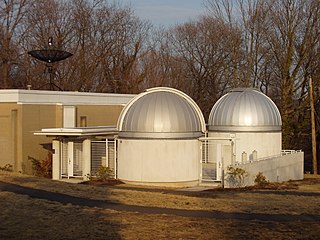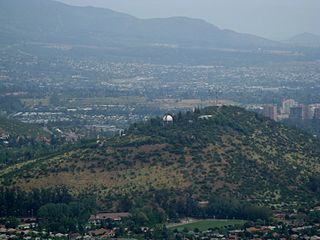
Yerkes Observatory is an astronomical observatory located in Williams Bay, Wisconsin, United States. The observatory was operated by the University of Chicago Department of Astronomy and Astrophysics from its founding in 1897 until 2018. Ownership was transferred to the non-profit Yerkes Future Foundation (YFF) in May 2020, which began millions of dollars of restoration and renovation of the historic building and grounds. Yerkes re-opened for public tours and programming in May 2022. The April 2024 issue of National Geographic magazine featured a story about the Observatory and ongoing work to restore it to relevance for astronomy, public science engagement and exploring big ideas through art, science, culture and landscape. The observatory offers tickets to programs and tours on its website.

Williamina Paton Stevens Fleming was a pioneering Scottish astronomer, who made significant contributions to the field despite facing gender biases. She was a single mother hired by the director of the Harvard College Observatory to help in the photographic classification of stellar spectra. She helped develop a common designation system for stars and cataloged more than ten thousand stars, 59 gaseous nebulae, over 310 variable stars, and 10 novae and other astronomical phenomena. Among several career achievements that advanced astronomy, Fleming is noted for her discovery of the Horsehead Nebula in 1888. Fleming's work has had a lasting impact on our understanding of the universe.

Annie Jump Cannon was an American astronomer whose cataloging work was instrumental in the development of contemporary stellar classification. With Edward C. Pickering, she is credited with the creation of the Harvard Classification Scheme, which was the first serious attempt to organize and classify stars based on their temperatures and spectral types. She was nearly deaf throughout her career after 1893, as a result of scarlet fever. She was a suffragist and a member of the National Women's Party.

Edward Charles Pickering was an American astronomer and physicist and the older brother of William Henry Pickering. Along with Carl Vogel, Pickering discovered the first spectroscopic binary stars. He wrote Elements of Physical Manipulations.

William Cranch Bond was an American astronomer, and the first director of Harvard College Observatory.

Henrietta Swan Leavitt was an American astronomer. Her discovery of how to effectively measure vast distances to remote galaxies led to a shift in the scale and understanding of the scale and the nature of the universe. Nomination of Leavitt for the Nobel Prize had to be halted because of her death.
Boyden Observatory is an astronomical research observatory and science education centre located in Maselspoort, 20 kilometres (12 mi) north-east of the city of Bloemfontein in Free State, South Africa. The observatory is managed by the Physics Department of the University of the Free State (UFS). The Friends of Boyden assist the observatory as a public support group, organising open evenings and protecting its public interest. Boyden also makes use of members of ASSA Bloemfontein Centre, the amateur astronomy club of the city, for presenters and telescope assistants.

The Smithsonian Astrophysical Observatory (SAO) is a research institute of the Smithsonian Institution, concentrating on astrophysical studies including galactic and extragalactic astronomy, cosmology, solar, earth and planetary sciences, theory and instrumentation, using observations at wavelengths from the highest energy gamma rays to the radio, along with gravitational waves. Established in Washington, D.C., in 1890, the SAO moved its headquarters in 1955 to Cambridge, Massachusetts, where its research is a collaboration with the Harvard College Observatory (HCO) and the Harvard University Department of Astronomy. In 1973, the Smithsonian and Harvard formalized the collaboration as the Center for Astrophysics | Harvard & Smithsonian (CfA) under a single Director.

The Center for Astrophysics | Harvard & Smithsonian (CfA), previously known as the Harvard–Smithsonian Center for Astrophysics, is an astrophysics research institute jointly operated by the Harvard College Observatory and Smithsonian Astrophysical Observatory. Founded in 1973 and headquartered in Cambridge, Massachusetts, United States, the CfA leads a broad program of research in astronomy, astrophysics, Earth and space sciences, as well as science education. The CfA either leads or participates in the development and operations of more than fifteen ground- and space-based astronomical research observatories across the electromagnetic spectrum, including the forthcoming Giant Magellan Telescope (GMT) and the Chandra X-ray Observatory, one of NASA's Great Observatories.

The Leander McCormick Observatory is one of the astronomical observatories operated by the Department of Astronomy of the University of Virginia, and is situated just outside Charlottesville, Virginia (US) in Albemarle County on the summit of Mount Jefferson. It is named for Leander J. McCormick (1819–1900), who provided the funds for the telescope and observatory.

The Fred Lawrence Whipple Observatory is an American astronomical observatory owned and operated by the Smithsonian Astrophysical Observatory (SAO); it is their largest field installation outside of their main site in Cambridge, Massachusetts. It is located near Amado, Arizona on the summit of Mount Hopkins.

John Adams Whipple was an American inventor and early photographer. He was the first in the United States to manufacture the chemicals used for daguerreotypes. He pioneered astronomical and night photography. He was a prize-winner for his extraordinary early photographs of the moon and he was the first to produce images of stars other than the sun. Among those was the star Vega and the Mizar-Alcor stellar sextuple system, which was thought to be a double star until 2009.

The Yale University Observatory, also known as the Leitner Family Observatory and Planetarium, is an astronomical observatory owned and operated by Yale University, and maintained for student use. It is located in Farnham Memorial Gardens near the corner of Edwards and Prospect Streets, New Haven, Connecticut.
Lisa Jennifer Kewley is an Australian Astrophysicist and current Director of the Center for Astrophysics | Harvard & Smithsonian. Previously, Kewley was Director of the ARC Centre of Excellence for All Sky Astrophysics in 3-D and ARC Laureate Fellow at the Australian National University College of Physical and Mathematical Sciences, where she was also a Professor. Specialising in galaxy evolution, she won the Annie Jump Cannon Award in Astronomy in 2005 for her studies of oxygen in galaxies, and the Newton Lacy Pierce Prize in Astronomy in 2008. In 2014 she was elected a fellow of the Australian Academy of Science. In 2020 she received the James Craig Watson Medal. In 2021 she was elected as an international member of the National Academy of Sciences. In 2022 she became the first female director of the Center for Astrophysics | Harvard & Smithsonian.

Leibniz Institute for Astrophysics Potsdam (AIP) is a German research institute. It is the successor of the Berlin Observatory founded in 1700 and of the Astrophysical Observatory Potsdam (AOP) founded in 1874. The latter was the world's first observatory to emphasize explicitly the research area of astrophysics. The AIP was founded in 1992, in a re-structuring following the German reunification.

The Harvard Computers were a team of women working as skilled workers to process astronomical data at the Harvard College Observatory in Cambridge, Massachusetts, United States. The team was directed by Edward Charles Pickering and, following his death in 1919, by Annie Jump Cannon.
The women were challenged to make sense of these patterns by devising a scheme for sorting the stars into categories. Annie Jump Cannon's success at this activity made her famous in her own lifetime, and she produced a stellar classification system that is still in use today. Antonia Maury discerned in the spectra a way to assess the relative sizes of stars, and Henrietta Leavitt showed how the cyclic changes of certain variable stars could serve as distance markers in space.

The National Astronomical Observatory of Chile is an astronomical observatory owned and operated by the Department of Astronomy of the University of Chile (UCh). It is located on Cerro Calán, a hill in the commune of Las Condes. The commune is an eastern suburb of Santiago located in Santiago Province of the Santiago Metropolitan Region. OAN was founded in 1852 and became a part of UCh in 1927. The facility on Cerro Calán was completed in 1962.

The Digital Access to a Sky Century @ Harvard (DASCH) is a project to preserve and digitize images recorded on astronomical photographic plates created before astronomy became dominated by digital imaging. It is a major project of the Center for Astrophysics | Harvard & Smithsonian. Over 500,000 glass plates held by the Harvard College Observatory are to be digitized. The digital images will contribute to time domain astronomy, providing over a hundred years of data that may be compared to current observations.

In astronomy, a period-luminosity relation is a relationship linking the luminosity of pulsating variable stars with their pulsation period. The best-known relation is the direct proportionality law holding for Classical Cepheid variables, sometimes called the Leavitt Law. Discovered in 1908 by Henrietta Swan Leavitt, the relation established Cepheids as foundational indicators of cosmic benchmarks for scaling galactic and extragalactic distances. The physical model explaining the Leavitt's law for classical cepheids is called kappa mechanism.

Potsdam Great Refractor is an historic astronomical telescope in an observatory in Potsdam, Germany.



















